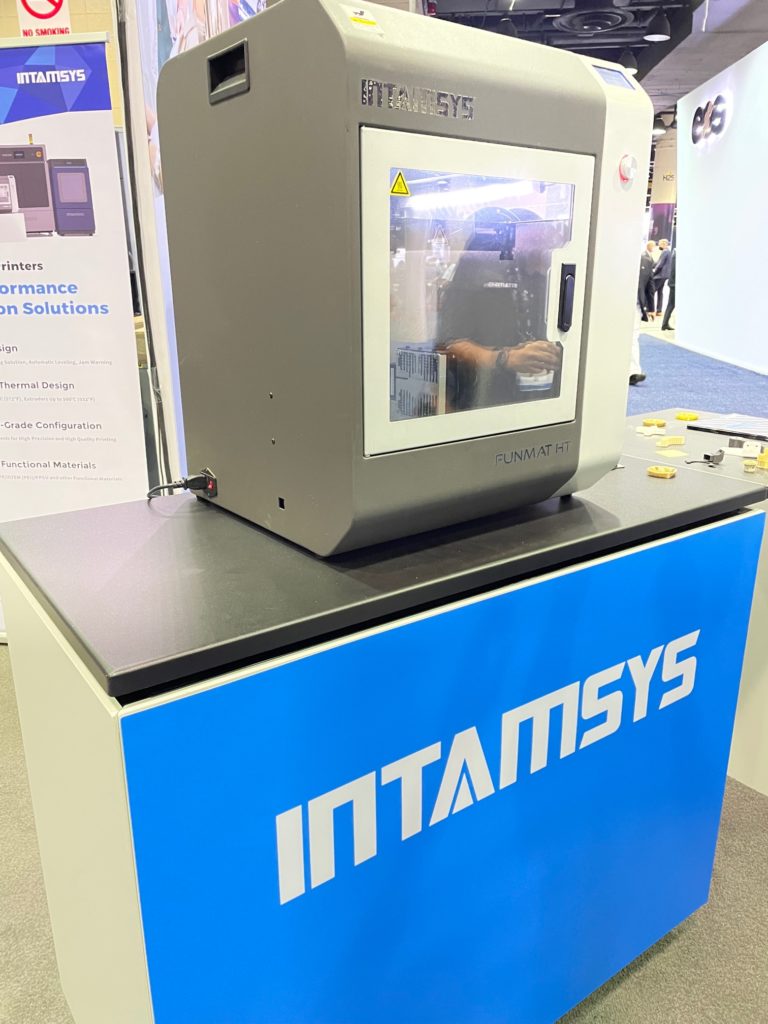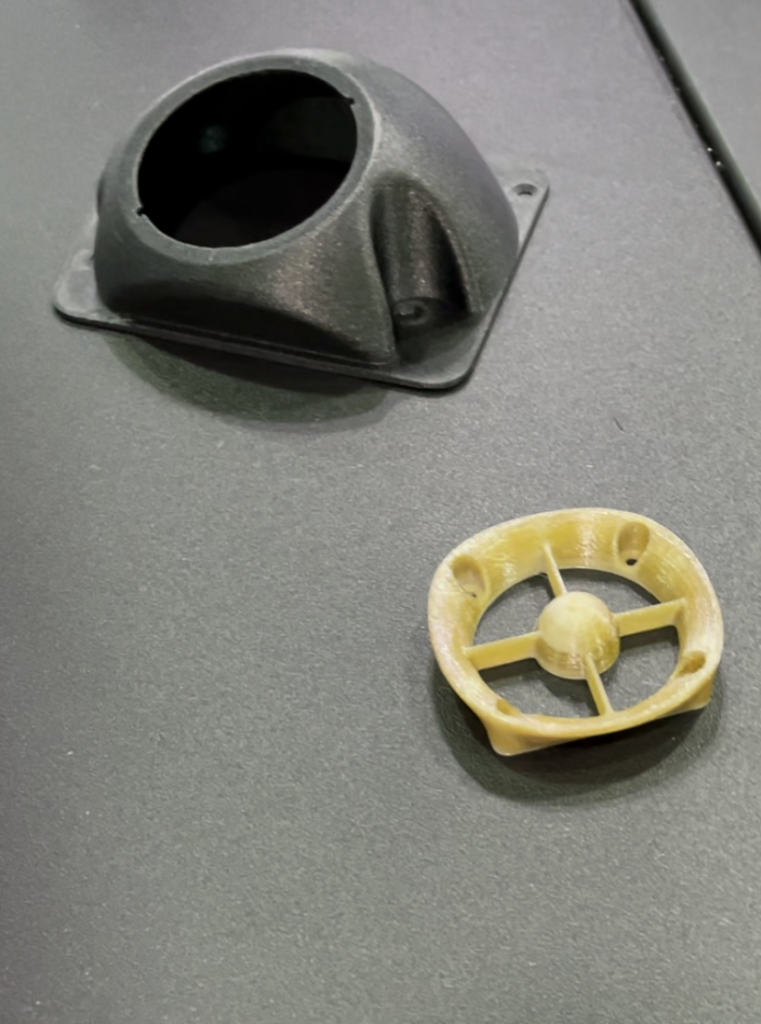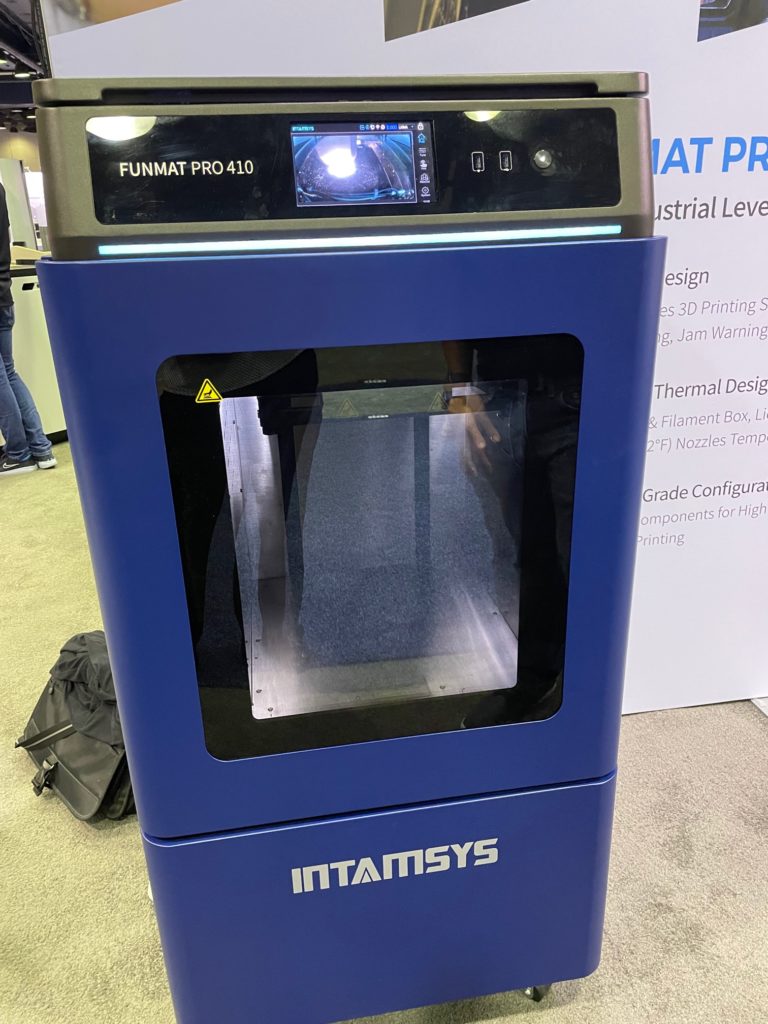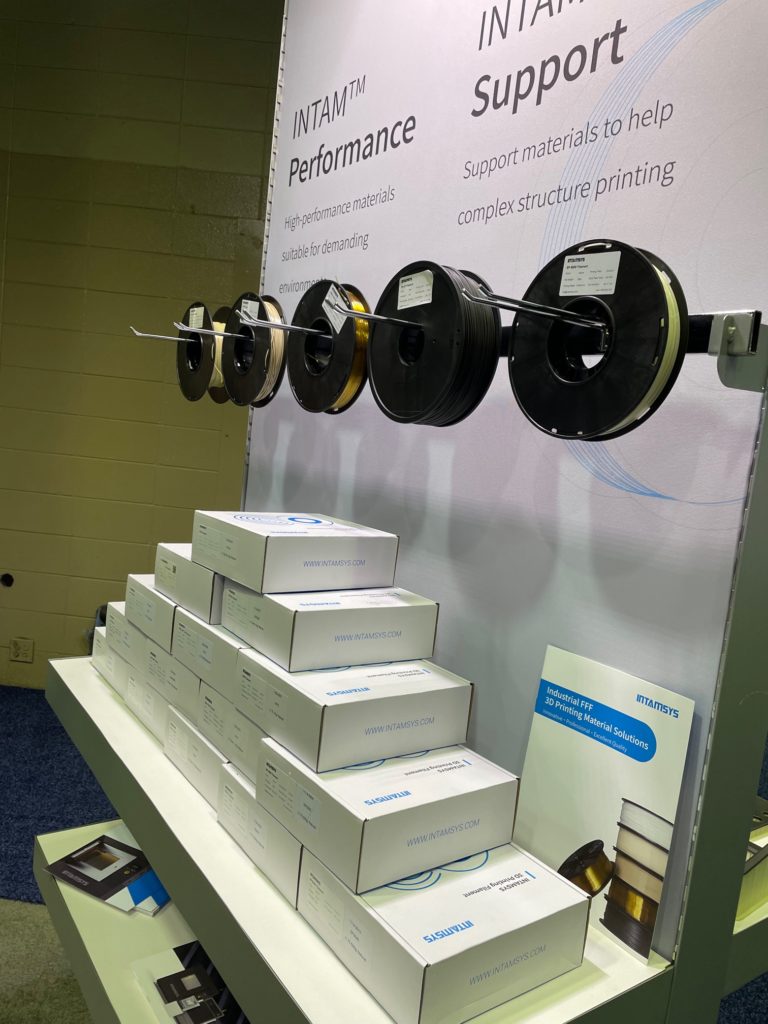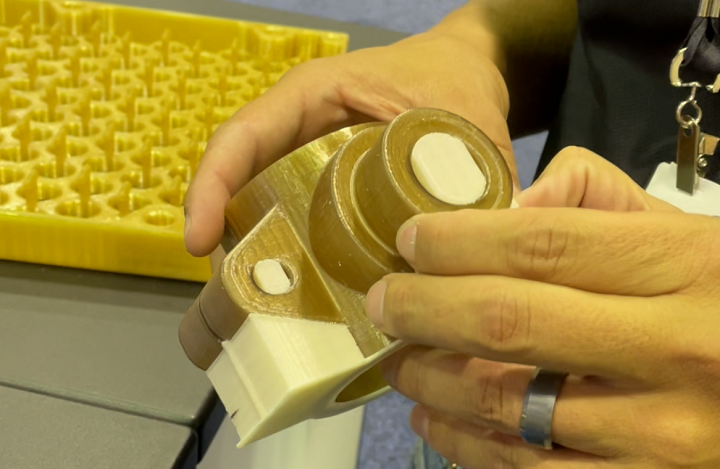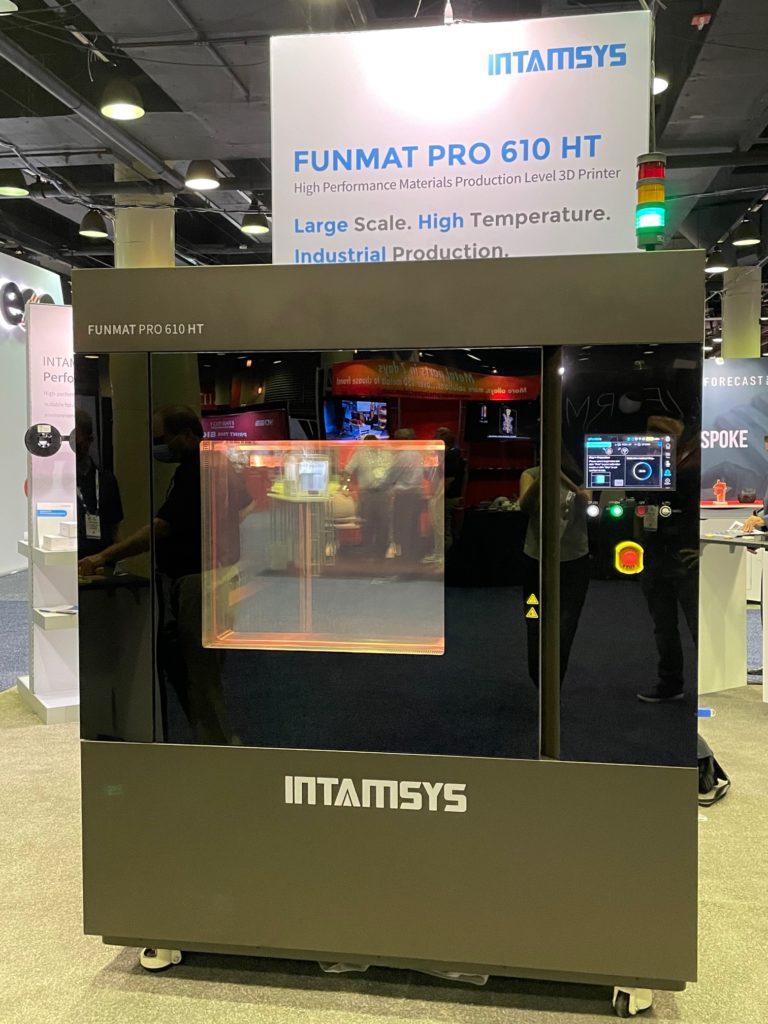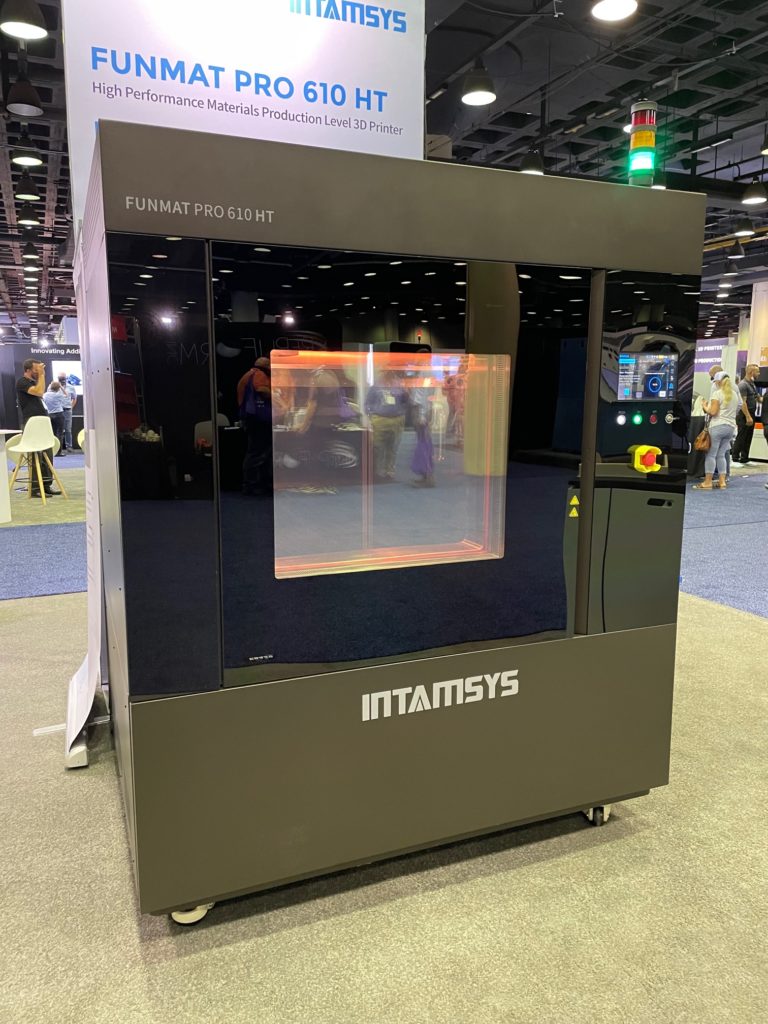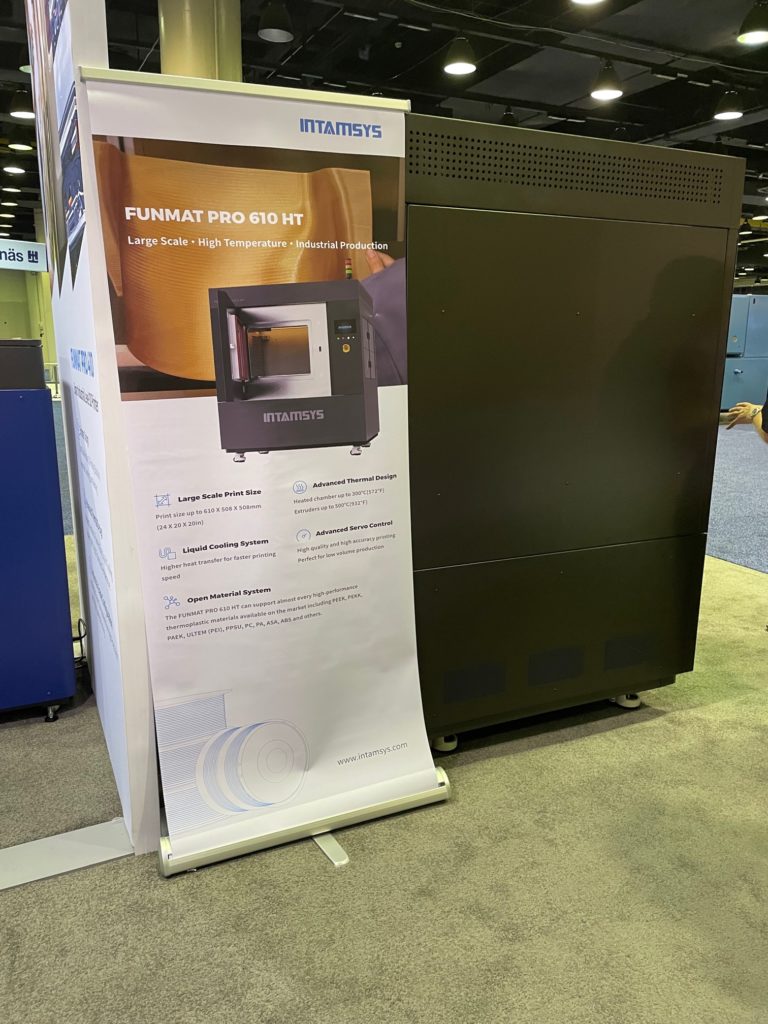Industrial-grade 3D printer manufacturer and AM solutions provider INTAMSYS, founded in 2013, is all about printing high-performance parts out of high-temperature plastics at a more affordable price. As Paul Carlson, Vice President – Americas, told me at the recent RAPID + TCT 2021 conference, the company’s first product is the FUNMAT HT, which retails for less than $10,000 and can print parts in up to 20 different materials right out of the box.
“And that’s just with the profiles built in,” he explained. “We’ve got an open materials strategy, which means that we’d love our customers to buy our materials, but they can actually use whatever materials they want. So if they already have a third-party supplier that they use, you have the ability to adjust 200 different parameters within the software to run whatever those materials are. But for the best user experience, we do recommend pairing an INTAMSYS material with an INTAMSYS product, and then it’s just plug and play, essentially.”
The FUNMAT HT is the company’s entry-level industrial system, and Carlson told me that a couple thousand of these printers have been installed worldwide. At that moment, the printer was busily fabricating a part out of PEEK, or polyetheretherketone, which is an INTAMSYS specialty.
“When we first started the company, we really honed in on PEEK, because there weren’t a lot of good options at the time, and it’s a very difficult material. So we’ve spent the last eight years trying to kind of perfect that process, and in the interim, we’ve been able to expand into some of those other high-performance materials.”
We moved to the dual-extrusion FUNMAT PRO 410 printer, which was introduced at RAPID 2019. Featuring a 12″ x 12″ x 16″ build volume, it’s similar to the FUNAMT HT in that it enables customers to easily print up to 20 materials right out of the box, with profiles already built in. If you didn’t know, INTAMSYS stands for INTelligent Additive Manufacturing SYStems, while FUNMAT is short for “functional materials,” and both monikers make a lot of sense. Carlson filled me in on me what’s so intelligent about the FUNMAT 3D printers:
“One of the super cool things is I can come in here before I start a print, and hold down on the INTAMSYS logo [on the touchscreen], and it will do an on-board diagnostic. It will show green lights for things that are performing great, yellow lights for things that need attention, and red lights if something’s wrong,” he explained. “So if I’ve got a 20-hour build, and I want to make sure that this thing is going to do it right, just hit the button, and if there’s something yellow or red, you pay attention to it, you replace it, and away you go. When we talk about building in intelligence into systems, that’s the type of thing we’re looking to do.”
The FUNMAT PRO 410, which is a sub-$30,000 printer, was the company’s fastest-growing product this year in terms of systems sales.
Speaking of products, Carlson then showed me the filaments on display. Not only does INTAMSYS manufacture some of its own materials, but it also partners with some third-party suppliers, including DSM, Polymaker, and Kimya, to certify materials and then sell them under the INTAMSYS brand. In fact, the company announced a partnership with BASF Forward AM at RAPID to expand industrial-grade 3D printing applications. Several high-performance engineering materials for FFF 3D printing were developed by BASF Forward AM, and its new Ultrafuse PC/ABS FR and Ultrafuse PPSU performed quite well on one of the high-temperature INTAMSYS systems.
“A lot of our focus is high-performance products, like ULTEM, PEEK, PEKK, PAEK, and we’ve got currently 25 different materials that we offer. We have developed some innovative support material options as well,” Carlson told me.
When it comes to high-temperature 3D printed products, removing support materials is challenging. That’s why INTAMSYS developed SP5000, which can be used with filaments like PEEK and ULTEM.
“It’s a hybrid material, where you take the part out and soak it in an ethyl acetate solution, which gums up the support and makes it easy to rip out, and then your part is ready to go,” Carlson explained. “It just makes the process easier.”
Explaining that the company has been focusing a little more on the industrial scale the last few years, he walked me over to the company’s latest high-temperature printer: the large-scale FUNMAT PRO 610 HT, just released in March and enjoying its public debut at RAPID 2021.
“We actually pre-launched last year, so we had a year to refine it,” Carlson clarified. “We had a couple of key customers who installed the system, and then we took that customer feedback and made improvements before it became production-ready.”
The new FUNMAT PRO 610 HT printer features a build volume of 24″ x 20″ x 20″, as well as a 300°C chamber, which Carlson says is “one of the highest, if not the highest, in the industry, which enables us to work with even more diverse plastics.”
“With that type of temperature, we’ve yet to find a filament that this machine cannot print,” he stated. “Take ULTEM, which is a popular but difficult material to work with because it has a tendency to peel and curl. With this system, we can build flat parts in ULTEM, ULTEM 1010, ULTEM 9085…this machine was really built for materials like that.”
Because the build chamber is so hot, all of the components inside that make up the printer’s interior—ball screws, stainless steel equipment, servo motors, and so on— have to be able to withstand those kinds of temperatures.
“This thing is built rock solid,” Carlson reiterated. “It weighs over 3,000 pounds, so it is super intense. Just look at some of the controls and motors that are in here…our customers tell us that we overengineer stuff, which is great…I guess, right?”
I wondered if that was a really backhanded compliment, but considering that overengineering can often occur when the safety or performance of a product is critical, I guess maybe that’s just par for the course. He decided to take it as a good thing.
Carlson showed me another great feature of the FUNMAT PRO 610 HT: four filament chambers, each of which are temperature-controlled based on what material is inside. To keep moisture out, each chamber has its own heater, and the filament flows faster and more reliably with dual nozzles. Going back to the INTelligent in INTAMSYS, the new 3D printer also features auto-cleaning nozzles, warnings for filament absences and jams, automatic filament reloading, over-heat protection, a liquid cooling system, and a Vacuum Absorption Platform.
What’s also interesting is that there are 14 3D printed components in this 3D printer, including a Y block, though none of them are in the chamber due to its extraordinarily high temperature; the FUNMAT PRO 410 features even more printed parts.
Carlson summed up why customers choose INTAMSYS:
‘We have customers that obviously build big parts. The precision on this system enables us to get into end part production, so customers who are looking to build a bunch of smaller parts. And then obviously heavy volumes, so those customers that have model shops and are running a lot of different materials. We’re one of the lowest in terms of total cost of ownership. The FUNMAT PRO 610 HT is priced at about $150,000 in the US, but when you look at your ongoing material costs, your ongoing maintenance costs, serviceability and things like that, you will find that we are amongst the lowest, if not the lowest, in the space in terms of FFF 3D printing.”
Stay tuned for more of my coverage from RAPID + TCT 2021!
Subscribe to Our Email Newsletter
Stay up-to-date on all the latest news from the 3D printing industry and receive information and offers from third party vendors.
You May Also Like
New Report: Semiconductor Industry to See $1.4B in 3D Printing Revenues by 2032
“The semiconductor sector has become the most strategically significant area of global industry.” Truer words are hard to come by when it comes to the modern world, and they are...
Will Photonic-Crystal Lasers Revolutionize 3D Printing?
Powder bed fusion (PBF) for metals and polymers predominantly utilizes lasers as the primary heat source. Some directed energy deposition (DED) technologies also employ lasers, while various vat polymerization methods...
3D Printing Unpeeled: Orbex Investment, IndoMIM and HP, Ultrasonic Waves
INDO-MIM has bought three HP Metal Jet S100 printers, operating two in India and one in Texas. This is a win for HP because the company has deep experience in...
3D Printing Webinar and Event Roundup: April 21, 2024
It’s another busy week of webinars and events, starting with Hannover Messe in Germany and continuing with Metalcasting Congress, Chinaplas, TechBlick’s Innovation Festival, and more. Stratasys continues its advanced training...


